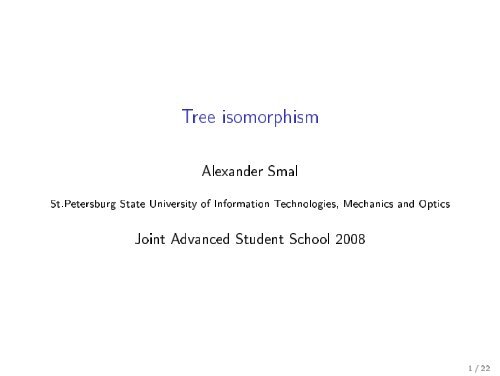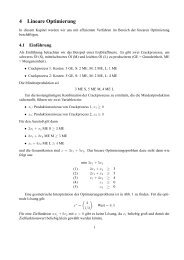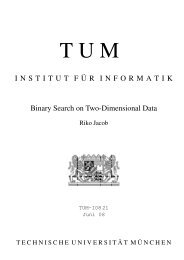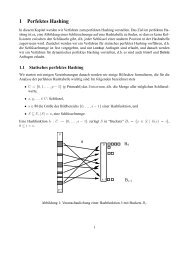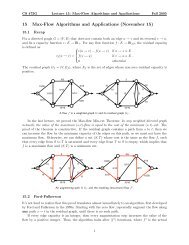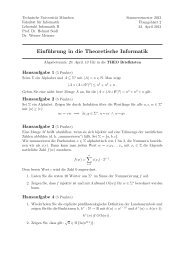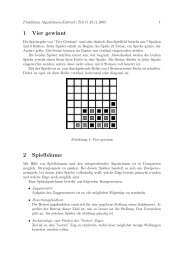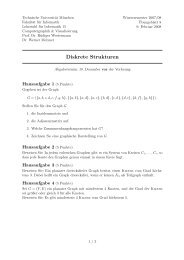Slides (PDF)
Slides (PDF)
Slides (PDF)
You also want an ePaper? Increase the reach of your titles
YUMPU automatically turns print PDFs into web optimized ePapers that Google loves.
Tree isomorphism<br />
Alexander Smal<br />
St.Petersburg State University of Information Technologies, Mechanics and Optics<br />
Joint Advanced Student School 2008<br />
1 / 22
Motivation<br />
In some applications the chemical structures are often trees with<br />
millions of vertices:<br />
• gene splicing,<br />
• protein analysis,<br />
• molecular biology.<br />
Difference between O(n), O(n log n), and O(n 2 ) isomorphism<br />
algorithms is not just theoretical importance.<br />
2 / 22
Graph isomorphism<br />
Definition<br />
Isomorphism of graphs G 1 (V 1 , E 1 ) and G 2 (V 2 , E 2 ) is a bijection<br />
between the vertex sets ϕ : V 1 → V 2 such that<br />
∀u, v ∈ V 1 (u, v) ∈ E 1 ⇔ (ϕ(u), ϕ(v)) ∈ E 2 .<br />
3 / 22
Graph isomorphism<br />
Definition<br />
Isomorphism of graphs G 1 (V 1 , E 1 ) and G 2 (V 2 , E 2 ) is a bijection<br />
between the vertex sets ϕ : V 1 → V 2 such that<br />
∀u, v ∈ V 1 (u, v) ∈ E 1 ⇔ (ϕ(u), ϕ(v)) ∈ E 2 .<br />
Facts<br />
• No algorithm, other than brute force, is known for testing<br />
whether two arbitrary graphs are isomorphic.<br />
3 / 22
Graph isomorphism<br />
Definition<br />
Isomorphism of graphs G 1 (V 1 , E 1 ) and G 2 (V 2 , E 2 ) is a bijection<br />
between the vertex sets ϕ : V 1 → V 2 such that<br />
∀u, v ∈ V 1 (u, v) ∈ E 1 ⇔ (ϕ(u), ϕ(v)) ∈ E 2 .<br />
Facts<br />
• No algorithm, other than brute force, is known for testing<br />
whether two arbitrary graphs are isomorphic.<br />
• It is still an open question (!) whether graph isomorphism is<br />
NP complete.<br />
3 / 22
Graph isomorphism<br />
Definition<br />
Isomorphism of graphs G 1 (V 1 , E 1 ) and G 2 (V 2 , E 2 ) is a bijection<br />
between the vertex sets ϕ : V 1 → V 2 such that<br />
∀u, v ∈ V 1 (u, v) ∈ E 1 ⇔ (ϕ(u), ϕ(v)) ∈ E 2 .<br />
Facts<br />
• No algorithm, other than brute force, is known for testing<br />
whether two arbitrary graphs are isomorphic.<br />
• It is still an open question (!) whether graph isomorphism is<br />
NP complete.<br />
• Polynomial time isomorphism algorithms for various graph<br />
subclasses such as trees are known.<br />
3 / 22
Rooted trees<br />
Definition<br />
Rooted tree (V , E, r) is a tree (V , E) with selected root r ∈ V .<br />
4 / 22
Rooted trees<br />
Definition<br />
Rooted tree (V , E, r) is a tree (V , E) with selected root r ∈ V .<br />
Definition<br />
Isomorphism of rooted trees T 1 (V 1 , E 1 , r 1 ) and T 2 (V 2 , E 2 , r 2 ) is<br />
a bijection between the vertex sets ϕ : V 1 → V 2 such that<br />
and ϕ(r 1 ) = r 2 .<br />
∀u, v ∈ V 1 (u, v) ∈ E 1 ⇔ (ϕ(u), ϕ(v)) ∈ E 2<br />
4 / 22
Rooted trees<br />
Definition<br />
Rooted tree (V , E, r) is a tree (V , E) with selected root r ∈ V .<br />
Definition<br />
Isomorphism of rooted trees T 1 (V 1 , E 1 , r 1 ) and T 2 (V 2 , E 2 , r 2 ) is<br />
a bijection between the vertex sets ϕ : V 1 → V 2 such that<br />
and ϕ(r 1 ) = r 2 .<br />
∀u, v ∈ V 1 (u, v) ∈ E 1 ⇔ (ϕ(u), ϕ(v)) ∈ E 2<br />
4 / 22
Rooted trees<br />
Definition<br />
Rooted tree (V , E, r) is a tree (V , E) with selected root r ∈ V .<br />
Definition<br />
Isomorphism of rooted trees T 1 (V 1 , E 1 , r 1 ) and T 2 (V 2 , E 2 , r 2 ) is<br />
a bijection between the vertex sets ϕ : V 1 → V 2 such that<br />
and ϕ(r 1 ) = r 2 .<br />
∀u, v ∈ V 1 (u, v) ∈ E 1 ⇔ (ϕ(u), ϕ(v)) ∈ E 2<br />
Example<br />
T 1 and T 2 are isomorphic as graphs . . .<br />
a<br />
B<br />
b<br />
c<br />
A C<br />
4 / 22
Rooted trees<br />
Definition<br />
Rooted tree (V , E, r) is a tree (V , E) with selected root r ∈ V .<br />
Definition<br />
Isomorphism of rooted trees T 1 (V 1 , E 1 , r 1 ) and T 2 (V 2 , E 2 , r 2 ) is<br />
a bijection between the vertex sets ϕ : V 1 → V 2 such that<br />
and ϕ(r 1 ) = r 2 .<br />
∀u, v ∈ V 1 (u, v) ∈ E 1 ⇔ (ϕ(u), ϕ(v)) ∈ E 2<br />
Example<br />
T 1 and T 2 are isomorphic as graphs but not as rooted trees!<br />
a<br />
B<br />
b<br />
c<br />
A C<br />
4 / 22
Rooted trees (part 2)<br />
Lemma<br />
If there is O(n) algorithm for rooted trees isomorphism there is<br />
O(n) algorithm for ordinary trees isomorphism.<br />
5 / 22
Rooted trees (part 2)<br />
Lemma<br />
If there is O(n) algorithm for rooted trees isomorphism there is<br />
O(n) algorithm for ordinary trees isomorphism.<br />
Proof.<br />
1 Let A to be O(n) algorithm for rooted trees.<br />
5 / 22
Rooted trees (part 2)<br />
Lemma<br />
If there is O(n) algorithm for rooted trees isomorphism there is<br />
O(n) algorithm for ordinary trees isomorphism.<br />
Proof.<br />
1 Let A to be O(n) algorithm for rooted trees.<br />
2 Let T 1 and T 2 to be ordinary trees.<br />
5 / 22
Rooted trees (part 2)<br />
Lemma<br />
If there is O(n) algorithm for rooted trees isomorphism there is<br />
O(n) algorithm for ordinary trees isomorphism.<br />
Proof.<br />
1 Let A to be O(n) algorithm for rooted trees.<br />
2 Let T 1 and T 2 to be ordinary trees.<br />
3 Lets find centers of this trees. There are three possibilities:<br />
5 / 22
Rooted trees (part 2)<br />
Lemma<br />
If there is O(n) algorithm for rooted trees isomorphism there is<br />
O(n) algorithm for ordinary trees isomorphism.<br />
Proof.<br />
1 Let A to be O(n) algorithm for rooted trees.<br />
2 Let T 1 and T 2 to be ordinary trees.<br />
3 Lets find centers of this trees. There are three possibilities:<br />
1 each tree has only one center (c 1 and c 2 respectively)<br />
return A(T 1 , c 1 , T 2 , c 2 )<br />
5 / 22
Rooted trees (part 2)<br />
Lemma<br />
If there is O(n) algorithm for rooted trees isomorphism there is<br />
O(n) algorithm for ordinary trees isomorphism.<br />
Proof.<br />
1 Let A to be O(n) algorithm for rooted trees.<br />
2 Let T 1 and T 2 to be ordinary trees.<br />
3 Lets find centers of this trees. There are three possibilities:<br />
1 each tree has only one center (c 1 and c 2 respectively)<br />
return A(T 1 , c 1 , T 2 , c 2 )<br />
2 each tree has exactly two centers (c 1 , c ′ 1 and c 2, c ′ 2<br />
respectively)<br />
return A(T 1 , c 1 , T 2 , c 2 ) or A(T 1 , c ′ 1 , T 2, c 2 )<br />
5 / 22
Rooted trees (part 2)<br />
Lemma<br />
If there is O(n) algorithm for rooted trees isomorphism there is<br />
O(n) algorithm for ordinary trees isomorphism.<br />
Proof.<br />
1 Let A to be O(n) algorithm for rooted trees.<br />
2 Let T 1 and T 2 to be ordinary trees.<br />
3 Lets find centers of this trees. There are three possibilities:<br />
1 each tree has only one center (c 1 and c 2 respectively)<br />
return A(T 1 , c 1 , T 2 , c 2 )<br />
2 each tree has exactly two centers (c 1 , c ′ 1 and c 2, c ′ 2<br />
respectively)<br />
return A(T 1 , c 1 , T 2 , c 2 ) or A(T 1 , c ′ 1 , T 2, c 2 )<br />
3 trees has different count of centers<br />
return False<br />
5 / 22
Diameter and center<br />
Definition<br />
The diameter of tree is the length of the longest path.<br />
6 / 22
Diameter and center<br />
Definition<br />
The diameter of tree is the length of the longest path.<br />
Definition<br />
A center is a vertex v such that the longest path from v to a leaf<br />
is minimal over all vertices in the tree.<br />
6 / 22
Diameter and center<br />
Definition<br />
The diameter of tree is the length of the longest path.<br />
Definition<br />
A center is a vertex v such that the longest path from v to a leaf<br />
is minimal over all vertices in the tree.<br />
Algorithm<br />
1: Choose a random root r.<br />
2: Find a vertex v 1 — the farthest form r.<br />
3: Find a vertex v 2 — the farthest form v 1 .<br />
4: Diameter is a length of path from v 1 to v 2 .<br />
5: Center is a median element(s) of path from v 1 to v 2 .<br />
6 / 22
Diameter and center<br />
Definition<br />
The diameter of tree is the length of the longest path.<br />
Definition<br />
A center is a vertex v such that the longest path from v to a leaf<br />
is minimal over all vertices in the tree.<br />
Algorithm<br />
1: Choose a random root r.<br />
2: Find a vertex v 1 — the farthest form r.<br />
3: Find a vertex v 2 — the farthest form v 1 .<br />
4: Diameter is a length of path from v 1 to v 2 .<br />
5: Center is a median element(s) of path from v 1 to v 2 .<br />
It is O(n) algorithm.<br />
6 / 22
The idea<br />
Let’s try to find complete invariant of rooted trees isomorphism.<br />
7 / 22
The idea<br />
Let’s try to find complete invariant of rooted trees isomorphism.<br />
Definition<br />
Isomorphism invariant is a function f (T ) such that<br />
f (T 1 ) = f (T 2 ) for all pairs of isomorphic trees T 1 and T 2 .<br />
7 / 22
The idea<br />
Let’s try to find complete invariant of rooted trees isomorphism.<br />
Definition<br />
Isomorphism invariant is a function f (T ) such that<br />
f (T 1 ) = f (T 2 ) for all pairs of isomorphic trees T 1 and T 2 .<br />
Definition<br />
Complete isomorphism invariant is a function f (T ) such that<br />
two trees T 1 and T 2 are isomorphic if and only if f (T 1 ) = f (T 2 ).<br />
7 / 22
The idea<br />
Let’s try to find complete invariant of rooted trees isomorphism.<br />
Definition<br />
Isomorphism invariant is a function f (T ) such that<br />
f (T 1 ) = f (T 2 ) for all pairs of isomorphic trees T 1 and T 2 .<br />
Definition<br />
Complete isomorphism invariant is a function f (T ) such that<br />
two trees T 1 and T 2 are isomorphic if and only if f (T 1 ) = f (T 2 ).<br />
So if we find complete isomorphism invariant we can obtain<br />
algorithm from it.<br />
7 / 22
The idea<br />
Let’s try to find complete invariant of rooted trees isomorphism.<br />
Definition<br />
Isomorphism invariant is a function f (T ) such that<br />
f (T 1 ) = f (T 2 ) for all pairs of isomorphic trees T 1 and T 2 .<br />
Definition<br />
Complete isomorphism invariant is a function f (T ) such that<br />
two trees T 1 and T 2 are isomorphic if and only if f (T 1 ) = f (T 2 ).<br />
So if we find complete isomorphism invariant we can obtain<br />
algorithm from it.<br />
Note<br />
Starting from the next slide tree means rooted tree!<br />
7 / 22
Candidate 1<br />
Observation<br />
The level number of a vertex is a tree isomorphism invariant.<br />
8 / 22
Candidate 1<br />
Observation<br />
The level number of a vertex is a tree isomorphism invariant.<br />
Conjecture<br />
Two trees are isomorphic if and only if they have the same number<br />
of levels and the same number of vertices on each level.<br />
8 / 22
Candidate 1<br />
Observation<br />
The level number of a vertex is a tree isomorphism invariant.<br />
Conjecture<br />
Two trees are isomorphic if and only if they have the same number<br />
of levels and the same number of vertices on each level.<br />
Observation<br />
The number of the leaves is a tree isomorphism invariant.<br />
8 / 22
Candidate 1<br />
Observation<br />
The level number of a vertex is a tree isomorphism invariant.<br />
Conjecture<br />
Two trees are isomorphic if and only if they have the same number<br />
of levels and the same number of vertices on each level.<br />
Observation<br />
The number of the leaves is a tree isomorphism invariant.<br />
Contrary instance<br />
a<br />
T 1 1 2 · · · n 1 2 · · · n T 2<br />
d e D E<br />
8 / 22<br />
A
Candidate 2<br />
What’s wrong with candidate 1?<br />
We didn’t take into account the spectrum degree of a tree.<br />
9 / 22
Candidate 2<br />
What’s wrong with candidate 1?<br />
We didn’t take into account the spectrum degree of a tree.<br />
Definition<br />
Degree spectrum of tree is the sequence of non-negative integers<br />
{d j }, where d j is the number of vertices that have j children.<br />
9 / 22
Candidate 2<br />
What’s wrong with candidate 1?<br />
We didn’t take into account the spectrum degree of a tree.<br />
Definition<br />
Degree spectrum of tree is the sequence of non-negative integers<br />
{d j }, where d j is the number of vertices that have j children.<br />
Conjecture<br />
Two trees are isomorphic if and only if they have the same degree<br />
spectrum.<br />
9 / 22
Candidate 2 (part 2)<br />
Observation<br />
Since a tree isomorphism preserves longest paths from the root, the<br />
number of levels in a tree is a tree isomorphism invariant.<br />
10 / 22
Candidate 2 (part 2)<br />
Observation<br />
Since a tree isomorphism preserves longest paths from the root, the<br />
number of levels in a tree is a tree isomorphism invariant.<br />
Contrary instance<br />
a<br />
A<br />
b c B C<br />
d e 1 D E<br />
T 1 T 2<br />
10 / 22<br />
1<br />
.<br />
.<br />
n<br />
n
Candidate 3<br />
Conjecture<br />
Two trees are isomorphic if and only if they have the same degree<br />
spectrum at each level.<br />
11 / 22
Candidate 3<br />
Conjecture<br />
Two trees are isomorphic if and only if they have the same degree<br />
spectrum at each level.<br />
If two trees have the same degree spectrum at each level, then they<br />
must automatically have the same numbers of levels, the same<br />
numbers of vertices at each level, and the same global degree<br />
spectrum!<br />
11 / 22
Candidate 3<br />
Conjecture<br />
Two trees are isomorphic if and only if they have the same degree<br />
spectrum at each level.<br />
If two trees have the same degree spectrum at each level, then they<br />
must automatically have the same numbers of levels, the same<br />
numbers of vertices at each level, and the same global degree<br />
spectrum!<br />
Observation<br />
The number of leaf descendants of a vertex and the level number of<br />
a vertex are both tree isomorphism invariants.<br />
11 / 22
Candidate 3 (part 2)<br />
Contrary instance<br />
a<br />
A<br />
level degree spectrum<br />
(0, 0, 1, 0, . . .)<br />
b c B C<br />
d e f D E F<br />
(0, 1, 1, 0, . . .)<br />
(2, 0, 1, 0, . . .)<br />
g<br />
1<br />
G<br />
1<br />
(1, 1, 0, 0, . . .)<br />
.<br />
.<br />
T 1 T 2<br />
12 / 22<br />
.<br />
n<br />
n<br />
(1, 0, 0, 0, . . .)
Algorithm by Aho, Hopcroft and Ullman<br />
• Determine tree isomorphism in time O(|V |).<br />
AHU algorithm<br />
• Uses complete history of degree spectrum of the vertex<br />
descendants as a complete invariant.<br />
13 / 22
Algorithm by Aho, Hopcroft and Ullman<br />
• Determine tree isomorphism in time O(|V |).<br />
AHU algorithm<br />
• Uses complete history of degree spectrum of the vertex<br />
descendants as a complete invariant.<br />
The idea of AHU algorithm<br />
The AHU algorithm associates with each vertex a tuple that<br />
describes the complete history of its descendants.<br />
13 / 22
Algorithm by Aho, Hopcroft and Ullman<br />
• Determine tree isomorphism in time O(|V |).<br />
AHU algorithm<br />
• Uses complete history of degree spectrum of the vertex<br />
descendants as a complete invariant.<br />
The idea of AHU algorithm<br />
The AHU algorithm associates with each vertex a tuple that<br />
describes the complete history of its descendants.<br />
Hard question<br />
Why our previous invariants are not complete?<br />
13 / 22
Algorithm by Aho, Hopcroft and Ullman<br />
• Determine tree isomorphism in time O(|V |).<br />
AHU algorithm<br />
• Uses complete history of degree spectrum of the vertex<br />
descendants as a complete invariant.<br />
The idea of AHU algorithm<br />
The AHU algorithm associates with each vertex a tuple that<br />
describes the complete history of its descendants.<br />
Hard question<br />
Why our previous invariants are not complete?<br />
Let’s discuss AHU algorithm. We start from O(|V | 2 ) version and<br />
then I tell how to make it faster (O(|V |)).<br />
13 / 22
Understanding AHU algorithm<br />
Knuth tuples<br />
Let’s assign parenthetical tuples to all tree vertices.<br />
14 / 22
Understanding AHU algorithm<br />
Knuth tuples<br />
Let’s assign parenthetical tuples to all tree vertices.<br />
Knuth tuples example<br />
A<br />
B<br />
C<br />
D<br />
E<br />
F<br />
G<br />
14 / 22
Understanding AHU algorithm<br />
Knuth tuples<br />
Let’s assign parenthetical tuples to all tree vertices.<br />
Knuth tuples example<br />
A<br />
B<br />
C<br />
D<br />
(0)<br />
E<br />
(0) F (0) G (0)<br />
14 / 22
Understanding AHU algorithm<br />
Knuth tuples<br />
Let’s assign parenthetical tuples to all tree vertices.<br />
Knuth tuples example<br />
A<br />
B<br />
((0))<br />
C<br />
D<br />
(0)<br />
E<br />
(0) F (0) G (0)<br />
14 / 22
Understanding AHU algorithm<br />
Knuth tuples<br />
Let’s assign parenthetical tuples to all tree vertices.<br />
Knuth tuples example<br />
A<br />
B<br />
((0)) ( (0) (0) )<br />
C<br />
D<br />
(0)<br />
E<br />
(0) F (0) G (0)<br />
14 / 22
Understanding AHU algorithm<br />
Knuth tuples<br />
Let’s assign parenthetical tuples to all tree vertices.<br />
Knuth tuples example<br />
A<br />
B<br />
((0)) ( (0) (0) )<br />
C<br />
D<br />
(0)<br />
E<br />
(0) F (0) G (0)<br />
14 / 22
Understanding AHU algorithm<br />
Knuth tuples<br />
Let’s assign parenthetical tuples to all tree vertices.<br />
Knuth tuples example<br />
A<br />
B<br />
((0)) ( (0) (0) )<br />
C<br />
D<br />
(0)<br />
E<br />
(0) F (0) G (0)<br />
14 / 22
Understanding AHU algorithm<br />
Knuth tuples<br />
Let’s assign parenthetical tuples to all tree vertices.<br />
Knuth tuples example<br />
A<br />
( ((0)) ((0)(0)) (0) )<br />
B<br />
((0)) ( (0) (0) )<br />
C<br />
D<br />
(0)<br />
E<br />
(0) F (0) G (0)<br />
14 / 22
Understanding AHU algorithm<br />
Knuth tuples<br />
Let’s assign parenthetical tuples to all tree vertices.<br />
Knuth tuples example<br />
A<br />
( ((0)) ((0)(0)) (0) )<br />
B<br />
((0)) ( (0) (0) )<br />
C<br />
D<br />
(0)<br />
E<br />
(0) F (0) G (0)<br />
14 / 22
Understanding AHU algorithm<br />
Knuth tuples<br />
Let’s assign parenthetical tuples to all tree vertices.<br />
Knuth tuples example<br />
A<br />
( ((0)) ((0)(0)) (0) )<br />
B<br />
C<br />
((0)) ( (0) (0) )<br />
D<br />
(0)<br />
E<br />
(0) F (0) G (0)<br />
14 / 22
Understanding AHU algorithm<br />
Knuth tuples<br />
Let’s assign parenthetical tuples to all tree vertices.<br />
Knuth tuples example<br />
A<br />
( ((0)) ((0)(0)) (0) )<br />
B<br />
((0)) ( (0) (0) )<br />
C<br />
D<br />
(0)<br />
E<br />
(0) F (0) G (0)<br />
14 / 22
Understanding AHU algorithm (part 2)<br />
There is algorithm Assign-Knuth-Tuples(v ) that visits every<br />
vertex once or twice.<br />
Assign-Knuth-Tuples(v)<br />
1: if v is a leaf then<br />
2: Give v the tuple name (0)<br />
3: else<br />
4: for all child w of v do<br />
5: Assign-Knuth-Tuples(w )<br />
6: end for<br />
7: end if<br />
8: Concatenate the names of all children of v to temp<br />
9: Give v the tuple name temp<br />
15 / 22
Understanding AHU algorithm (part 3)<br />
Observation<br />
There is no order on parenthetical tuples.<br />
16 / 22
Understanding AHU algorithm (part 3)<br />
Observation<br />
There is no order on parenthetical tuples.<br />
Example<br />
A<br />
( (0) ((0)) ) a ( ((0)) (0) )<br />
B<br />
(0)<br />
C<br />
((0)) b ((0))<br />
c<br />
(0)<br />
D<br />
(0)<br />
d<br />
(0)<br />
16 / 22
Understanding AHU algorithm (part 3)<br />
Observation<br />
There is no order on parenthetical tuples.<br />
Example<br />
A<br />
( (0) ((0)) ) a ( ((0)) (0) )<br />
B<br />
(0)<br />
C<br />
((0)) b ((0))<br />
c<br />
(0)<br />
D<br />
(0)<br />
d<br />
(0)<br />
Let’s convert parenthetical tuples to canonical names. We should<br />
drop all “0”-s and replace “(” and “)” with “1” and “0” respectively.<br />
16 / 22
Understanding AHU algorithm (part 3)<br />
Observation<br />
There is no order on parenthetical tuples.<br />
Example<br />
A<br />
1 10 1100 0 a 1 1100 10 0<br />
B<br />
10<br />
C<br />
1100 b 1100<br />
c<br />
10<br />
D<br />
10<br />
d<br />
10<br />
Let’s convert parenthetical tuples to canonical names. We should<br />
drop all “0”-s and replace “(” and “)” with “1” and “0” respectively.<br />
16 / 22
Understanding AHU algorithm (part 3)<br />
Observation<br />
There is no order on parenthetical tuples.<br />
Example<br />
A<br />
1 10 1100 0 a 1 10 1100 0<br />
B<br />
10<br />
C<br />
1100 b 1100<br />
c<br />
10<br />
D<br />
10<br />
d<br />
10<br />
Let’s convert parenthetical tuples to canonical names. We should<br />
drop all “0”-s and replace “(” and “)” with “1” and “0” respectively.<br />
16 / 22
Understanding AHU algorithm (part 4)<br />
Assign-Canonical-Names(v)<br />
1: if v is a leaf then<br />
2: Give v the tuple name “10”<br />
3: else<br />
4: for all child w of v do<br />
5: Assign-Canonical-Names(v )<br />
6: end for<br />
7: end if<br />
8: Sort the names of the children of v<br />
9: Concatenate the names of all children of v to temp<br />
10: Give v the name 1temp0<br />
17 / 22
Understanding AHU algorithm (part 5)<br />
We should discuss some important questions.<br />
18 / 22
Understanding AHU algorithm (part 5)<br />
We should discuss some important questions.<br />
Invariant?<br />
Is canonical name of a root is a tree isomorphism invariant?<br />
18 / 22
Understanding AHU algorithm (part 5)<br />
We should discuss some important questions.<br />
Invariant?<br />
Is canonical name of a root is a tree isomorphism invariant?<br />
Complete invariant?<br />
Is canonical name of a root is a complete tree isomorphism<br />
invariant?<br />
18 / 22
Understanding AHU algorithm (part 5)<br />
We should discuss some important questions.<br />
Invariant?<br />
Is canonical name of a root is a tree isomorphism invariant?<br />
Complete invariant?<br />
Is canonical name of a root is a complete tree isomorphism<br />
invariant?<br />
AHU-Tree-Isomorphism(T 1 (V 1 , E 1 , r 1 ), T 2 (V 2 , E 2 , r 2 ))<br />
1: Assign-Canonical-Names(r 1 )<br />
2: Assign-Canonical-Names(r 2 )<br />
3: if name(r 1 ) = name(r 2 ) then<br />
4: return True<br />
5: else<br />
6: return False<br />
7: end if<br />
18 / 22
AHU algorithm improvement<br />
Observation<br />
To compute the root name of a tree of n vertices in one long<br />
strand, takes time proportional to 1 + 2 + · · · + n, which is Ω(n 2 ).<br />
19 / 22
AHU algorithm improvement<br />
Observation<br />
To compute the root name of a tree of n vertices in one long<br />
strand, takes time proportional to 1 + 2 + · · · + n, which is Ω(n 2 ).<br />
Observation<br />
For all levels i, the canonical name of level i is a tree isomorphism<br />
invariant.<br />
19 / 22
AHU algorithm improvement<br />
Observation<br />
To compute the root name of a tree of n vertices in one long<br />
strand, takes time proportional to 1 + 2 + · · · + n, which is Ω(n 2 ).<br />
Observation<br />
For all levels i, the canonical name of level i is a tree isomorphism<br />
invariant.<br />
Observation<br />
Two trees T 1 and T 2 are isomorphic if and only if for all levels i<br />
canonical level names of T 1 and T 2 are identical.<br />
19 / 22
AHU algorithm improvement<br />
Observation<br />
To compute the root name of a tree of n vertices in one long<br />
strand, takes time proportional to 1 + 2 + · · · + n, which is Ω(n 2 ).<br />
Observation<br />
For all levels i, the canonical name of level i is a tree isomorphism<br />
invariant.<br />
Observation<br />
Two trees T 1 and T 2 are isomorphic if and only if for all levels i<br />
canonical level names of T 1 and T 2 are identical.<br />
The idea 1<br />
Assign canonical names level, sort by level, and check by level that<br />
the canonical level names agree.<br />
19 / 22
AHU algorithm improvement<br />
Observation<br />
To compute the root name of a tree of n vertices in one long<br />
strand, takes time proportional to 1 + 2 + · · · + n, which is Ω(n 2 ).<br />
Observation<br />
For all levels i, the canonical name of level i is a tree isomorphism<br />
invariant.<br />
Observation<br />
Two trees T 1 and T 2 are isomorphic if and only if for all levels i<br />
canonical level names of T 1 and T 2 are identical.<br />
The idea 1<br />
Assign canonical names level, sort by level, and check by level that<br />
the canonical level names agree.<br />
The idea 2<br />
Assign canonical names level and if canonical level names agree<br />
than replace canonical names with integers.<br />
19 / 22
AHU algorithm example<br />
Example<br />
A<br />
a<br />
B<br />
C<br />
b<br />
c 0<br />
D<br />
E<br />
d<br />
e<br />
1<br />
20 / 22
AHU algorithm example<br />
Example<br />
A<br />
a<br />
B<br />
C<br />
b<br />
c<br />
0<br />
D 0<br />
E 0<br />
d 0<br />
e 0<br />
1<br />
20 / 22
AHU algorithm example<br />
Example<br />
A<br />
a<br />
B<br />
C<br />
b<br />
c<br />
0<br />
D 1<br />
E 1<br />
d 1<br />
e 1<br />
1,1 1 1,1<br />
20 / 22
AHU algorithm example<br />
Example<br />
A<br />
a<br />
B<br />
C<br />
b<br />
c<br />
0<br />
D<br />
1 E 1 d 1 e 1<br />
1,1 1 1,1<br />
20 / 22
AHU algorithm example<br />
Example<br />
A<br />
a<br />
B 0<br />
C 1 1<br />
b 1 1<br />
c<br />
0<br />
D<br />
1 E 1 d 1 e 1<br />
1<br />
20 / 22
AHU algorithm example<br />
Example<br />
A<br />
a<br />
B 1 C<br />
2<br />
b 2<br />
c 1<br />
D<br />
1 E 1 d 1 e 1<br />
1,2 1 1,2<br />
20 / 22
AHU algorithm example<br />
Example<br />
A<br />
a<br />
B<br />
1 C 2<br />
b 2 c 1<br />
D<br />
1 E 1 d 1 e 1<br />
1,2 1 1,2<br />
20 / 22
AHU algorithm example<br />
Example<br />
A 1 2<br />
a 1 2<br />
B<br />
1 C 2<br />
b 2 c 1<br />
D<br />
1 E 1 d 1 e 1<br />
1<br />
20 / 22
AHU algorithm example<br />
Example<br />
A 1<br />
a 1<br />
B<br />
1 C 2<br />
b 2 c 1<br />
D<br />
1 E 1 d 1 e 1<br />
1 1 1<br />
20 / 22
AHU algorithm example<br />
Example<br />
A<br />
1 a 1<br />
B<br />
1 C 2<br />
b 2 c 1<br />
D<br />
1 E 1 d 1 e 1<br />
1 1 1<br />
20 / 22
AHU algorithm example<br />
Example<br />
A<br />
1 a 1<br />
B<br />
1 C 2<br />
b 2 c 1<br />
D<br />
1 E 1 d 1 e 1<br />
OK<br />
1<br />
20 / 22
Resume<br />
Resume<br />
• We have three unsuccessful tries to construct complete tree<br />
isomorphism invariant.<br />
• We discussed O(|V | 2 ) version of AHU algorithm.<br />
• We discussed ways of improvement of AHU algorithm to make<br />
it work in O(|V |) time.<br />
21 / 22
Thank you for your attention!<br />
Any questions?<br />
22 / 22


